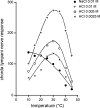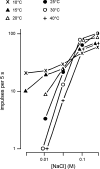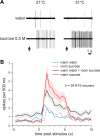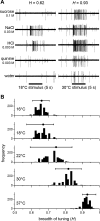Modulation of taste processing by temperature
- PMID: 28794101
- PMCID: PMC5668616
- DOI: 10.1152/ajpregu.00089.2017
Modulation of taste processing by temperature
Abstract
Taste stimuli have a temperature that can stimulate thermosensitive neural machinery in the mouth during gustatory experience. Although taste and oral temperature are sometimes discussed as different oral sensory modalities, there is a body of literature that demonstrates temperature is an important component and modulator of the intensity of gustatory neural and perceptual responses. Available data indicate that the influence of temperature on taste, herein referred to as "thermogustation," can vary across taste qualities, can also vary among stimuli presumed to share a common taste quality, and is conditioned on taste stimulus concentration, with neuronal and psychophysical data revealing larger modulatory effects of temperature on gustatory responding to weakened taste solutions compared with concentrated. What is more, thermogustation is evidenced to involve interplay between mouth and stimulus temperature. Given these and other dependencies, identifying principles by which thermal input affects gustatory information flow in the nervous system may be important for ultimately unravelling the organization of neural circuits for taste and defining their involvement with multisensory processing related to flavor. Yet thermal effects are relatively understudied in gustatory neuroscience. Major gaps in our understanding of the mechanisms and consequences of thermogustation include delineating supporting receptors, the potential involvement of oral thermal and somatosensory trigeminal neurons in thermogustatory interactions, and the broader operational roles of temperature in gustatory processing. This review will discuss these and other issues in the context of the literature relevant to understanding thermogustation.
Keywords: flavor; multisensory; somatosensation; taste; temperature.
Copyright © 2017 the American Physiological Society.
Figures






Similar articles
-
TRPV1-Lineage Somatosensory Fibers Communicate with Taste Neurons in the Mouse Parabrachial Nucleus.J Neurosci. 2022 Mar 2;42(9):1719-1737. doi: 10.1523/JNEUROSCI.0927-21.2021. Epub 2022 Jan 13. J Neurosci. 2022. PMID: 35027408 Free PMC article.
-
Cortical coding of gustatory and thermal signals in active licking mice.J Physiol. 2025 Feb;603(4):909-928. doi: 10.1113/JP287499. Epub 2025 Jan 19. J Physiol. 2025. PMID: 39827405
-
Mouse Parabrachial Neurons Signal a Relationship between Bitter Taste and Nociceptive Stimuli.J Neurosci. 2019 Feb 27;39(9):1631-1648. doi: 10.1523/JNEUROSCI.2000-18.2018. Epub 2019 Jan 3. J Neurosci. 2019. PMID: 30606758 Free PMC article.
-
The gustatory cortex and multisensory integration.Int J Obes (Lond). 2009 Jun;33 Suppl 2(Suppl 2):S34-43. doi: 10.1038/ijo.2009.70. Int J Obes (Lond). 2009. PMID: 19528978 Free PMC article. Review.
-
Neural Ensemble Recordings from Central Gustatory-Reward Pathways in Awake and Behaving Animals.In: Nicolelis MAL, editor. Methods for Neural Ensemble Recordings. 2nd edition. Boca Raton (FL): CRC Press/Taylor & Francis; 2008. Chapter 10. In: Nicolelis MAL, editor. Methods for Neural Ensemble Recordings. 2nd edition. Boca Raton (FL): CRC Press/Taylor & Francis; 2008. Chapter 10. PMID: 21204447 Free Books & Documents. Review.
Cited by
-
Tasting temperature: neural and behavioral responses to thermal stimulation of oral mucosa.Curr Opin Physiol. 2021 Apr;20:16-22. doi: 10.1016/j.cophys.2020.12.005. Epub 2021 Jan 13. Curr Opin Physiol. 2021. PMID: 33937598 Free PMC article.
-
Reduced menthol sensitivity in a prodromal Parkinson's disease model induced by intranasal rotenone treatment.Front Cell Neurosci. 2024 Feb 6;18:1345651. doi: 10.3389/fncel.2024.1345651. eCollection 2024. Front Cell Neurosci. 2024. PMID: 38380382 Free PMC article.
-
Heterogeneity of neuronal responses in the nucleus of the solitary tract suggests sensorimotor integration in the neural code for taste.J Neurophysiol. 2019 Feb 1;121(2):634-645. doi: 10.1152/jn.00578.2018. Epub 2018 Dec 19. J Neurophysiol. 2019. PMID: 30565959 Free PMC article.
-
State-Dependent Modification of Sensory Sensitivity via Modulation of Backpropagating Action Potentials.eNeuro. 2018 Sep 11;5(4):ENEURO.0283-18.2018. doi: 10.1523/ENEURO.0283-18.2018. eCollection 2018 Jul-Aug. eNeuro. 2018. PMID: 30225349 Free PMC article.
-
Effect of the parasympathetic vasodilation on temperature regulation via trigeminal afferents in the orofacial area.J Physiol Sci. 2020 Mar 31;70(1):22. doi: 10.1186/s12576-020-00749-y. J Physiol Sci. 2020. PMID: 32234014 Free PMC article.
References
-
- Abbott P. The Effect of Temperature on Taste in the White Rat (PhD Thesis) Brown University, 1953.
-
- Afroz A, Howlett N, Shukla A, Ahmad F, Batista E, Bedard K, Payne S, Morton B, Mansfield JH, Glendinning JI. Gustatory receptor neurons in Manduca sexta contain a TrpA1-dependent signaling pathway that integrates taste and temperature. Chem Senses 38: 605–617, 2013. doi:10.1093/chemse/bjt032. - DOI - PMC - PubMed
-
- Arai T, Ohkuri T, Yasumatsu K, Kaga T, Ninomiya Y. The role of transient receptor potential vanilloid-1 on neural responses to acids by the chorda tympani, glossopharyngeal and superior laryngeal nerves in mice. Neuroscience 165: 1476–1489, 2010. doi:10.1016/j.neuroscience.2009.11.051. - DOI - PubMed
Publication types
MeSH terms
Grants and funding
LinkOut - more resources
Full Text Sources
Other Literature Sources

